INTRODUCTION
Chiasm and Chiastic Structures: Background
We have talked about chiastic structures in John in other articles, and have even seen a few examples, such as the O.T. Quotation structure:
O.T. Quotation Structure in John <-- Click Here for Article.
Briefly speaking, a 'chiasm', or chiastic pattern is a structure or pattern built into a piece of prose which has certain features. What makes it a pattern is the repetition of similar elements or related items. What makes it chiastic, is the reversal in order of the second set of repeated elements.
The easiest kind of chiasm to understand is in poetry, where endings of sentences that rhyme are put in reversed order for variety and effect. Lets look at an example. John uses chiastic structures liberally at all conceivable levels, but the easiest to spot are the simple words or phrases repeated in reverse order later in the same passage:
Chiastic Patterns of Phrases
The Chiastic Pattern in John 6:22-59 | ||
| Verse | Level | Details |
| 6:24 | (a) | Capernaum |
| 6:27 | ..(b) | the food which leads to Eternal Life |
| 6:32 | ....(c) | the true bread from heaven |
| 6:35 | ......(d) | I am the Bread of Life |
| 6:36 | ........(e) | you have seen Me and yet don't believe |
| 6:37 | ..........(f) | all people that the Father gives Me come to Me |
| 6:40 | ............(g) | I will raise him (My disciple) up on the Last Day |
| 6:42 | center | "Jesus the son of Joseph" |
| 6:44 | ............(g) | I will raise him (My disciple) up on the Last Day |
| 6:45 | ..........(f) | everyone learning from the Father comes to Me |
| 6:47 | ........(e) | whoever believes has Eternal Life |
| 6:48 | ......(d) | I am the Bread of Life |
| 6:51 | ....(c) | the living bread from heaven |
| 6:55 | ..(b) | My flesh is the true food |
| 6:59 | (a) | Capernaum |
| . | ||
| color code: | ||
| - purple | (a) = level 1 | |
| - blue | (b) = level 2 | |
| - green | (c) = level 3 | |
| - yellow | (d) = level 4 | |
| - orange | (e) = level 5 | |
| - red | (f) = level 6 | |
| - mauve | (g) = level 7 | |
| This passage is a core section from John 6, the Feeding of the 5000 and related discourses. | ||
| . | ||
As one can see, embedding a chiastic structure within a passage serves multiple purposes (e.g.) :
(1) It can focus the ideas into a coherent and powerful edifice, for instruction and memorization.
(2) It can protect a passage from accidental copying errors or from amateurish tampering.
From our end, we can use these chiastic structures to detect tampering or loss in a given text. The advantage in examining chiastic structures, is that they are physically and empirically determined, and do not permit the degree of subjectivity often associated with other methods or interpretations of 'internal evidence'.
LARGER CHIASTIC PATTERNS IN JOHN
Chiastic Patterns at the Paragraph Level
John the Evangelist does not limit himself to simple word matches or phrase patterns. He continuously builds ever higher and larger, constructing his gospel from the bottom up as well as from the top down.
The next higher distinct class of chiastic structure in John is at the passage or paragraph level. These larger blocks of text are not coordinated by mere words or phrases, but rather by concepts and themes.
In this case also, the very structure of the Gospel can be used for textual-critical purposes, to help determine the plausibility of a given arrangement, or the integrity of a given extant text-type, manuscript or variant.
In the Part of John known as the "INFESTO SCENOPEGIAE JERUSALEM" (John 7:1-10:19), we have again a large set of sections or passages which are chiastically organized, as can be seen by their self-contained themes and content.
We call this chiastic section of John the Mount of Olives Chiasm for reasons which will become obvious when the section is examined.
The Mount of Olives Chiasm
(a) ¶ 7:14-14 - 'Jesus went up into the Temple...'
the Law, murder plot, demons(b) ¶ 7:25-36 - The Christ's Origin:
"we know where he is from!"
The Christ's signs,
"a little while, ...you cannot come"(c) ¶ 7:37-39 - The Source of Living Water: "come to Me and drink!"
(d) ¶ 7:40-7:52 - The Prophet, Pharisees: "this crowd that doesn't know Law is cursed"
Nicodemus: "Does our Law judge without hearing?"'And each departed to his own house,
but Jesus departed to the Mount of Olives.
( ¶ 7:53-8:1)(d) ¶ 8:2-11 - 'And He was teaching them',
crowd, a test case: adultery,
'and hearing, they left one by one'(c) ¶ 8:12 - The Light of the World:
"the Light of Life"(b) ¶ 8:13-29 - Witness, judgment:
"you don't know Me or My Father"
sin, "a little while,...you cannot come"¶ 8:30-59 - Abraham, murder plot, demons
'but Jesus ....went out of the Temple'
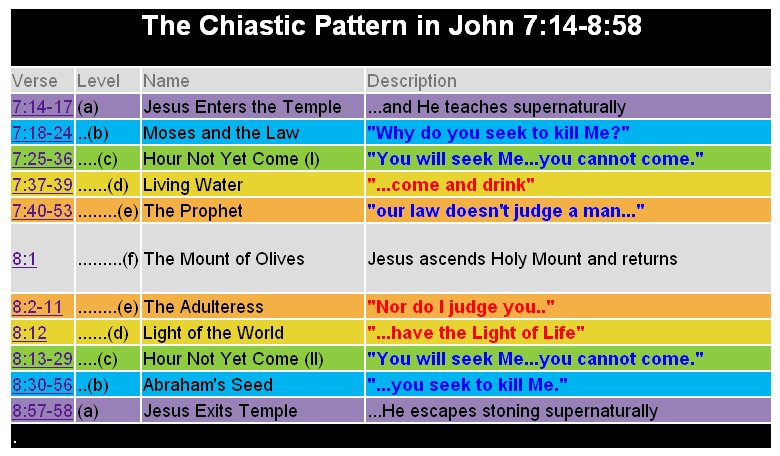
Nazaroo's footnotes:
The amazing insight this chiasmic structure offers is that the earthly Temple is a mere outer gate, an interface to the world. All that is important takes place well inside the ascending ladder to ...
the Mount of Olives.
The real Holy Place, the launching pad where Jesus literally ascends to heaven and returns is here.
On His way back from the Mount, He is confronted with the adultery test-case. There is little doubt that the author of this incident intends us to see the woman as a typology for the Southern kingdom of Judaea, an Adulteress.
The irony in their persistence should not be lost, as Jesus mercifully declines to judge her, and postpones the trial.
Instead He again preaches as the Light of the World, a last attempt to save men from the coming judgement.
Detailed Look at Chiastic Elements
We have prepared a detailed layout of this group of sections, in Greek. We have two versions, one for Internet Explorer with the Symbol Font, and one for Firefox with Unicode. However it was done in Unicode to allow easy access via any browser, so you need to have a UNICODE font installed (Windows comes with one, but if you are using Firefox or running Linux, you can download and install the 'Gentium' font. A link on the page with Instructions are online.)
Mount of Olives Chiasm (Greek) <-- Click Here for detailed layout!
Mount of Olives Chiasm (English) <-- Click Here for detailed layout!
Text-Critical Significance
Each paragraph is related to its twin by an enclosed discussion of a set of related topics.
Note that John 8:1-11 is clearly a part of the built-in structure of this entire section, and includes the central pivot-point, Jesus on the Mount of Olives.
Deleting the passage does not remove the chiastic structure, but merely damages it, and leaves it unbalanced, with no sensible central focus and little to recommend the result.
This shows that whoever omitted the passage was wholly unaware of this chiastic structure, just as they were unaware of all the other internal structural keys which authenticate the passage.
This inter-passage chiastic connection was not discovered by us, nor is it controversial in itself.
Other Chiastic Structures
Chiastic Structures in Discourse
Other independant researchers in chiastic structure have found many other chiastic patterns in John's gospel. This shows that such structures are not incidental or accidental, but are woven throughout the book.
The following examples are taken from John Sweigart's website, where he has posted an abundant wealth of examples, many from John:
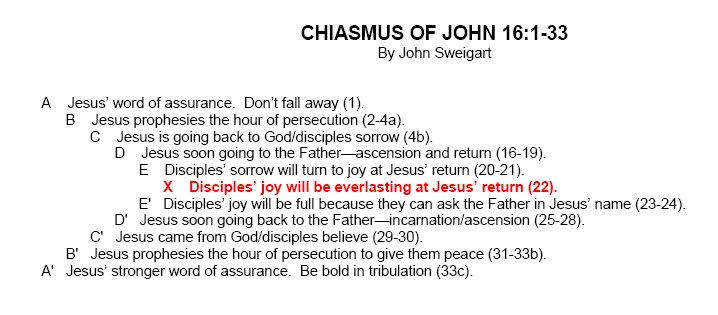
The above example shows that John's use of this technique is not limited to narrative, or any particular portion of the gospel. These patterns occur from one end to the other, and cross all content boundaries.
Chiastic Structures Involving John 8:1-11
Of great importance are two new chiastic structures discovered by John Sweigart which clearly involve the Pericope de Adultera (John 8:1-11).
In the first pattern, the story of the Woman Taken in Adultery forms the first section, and plainly compliments the final stunning section in which Jesus supernaturally escapes from being stoned Himself. This connection is made stronger by the five-layer chiasm between the two incidents.
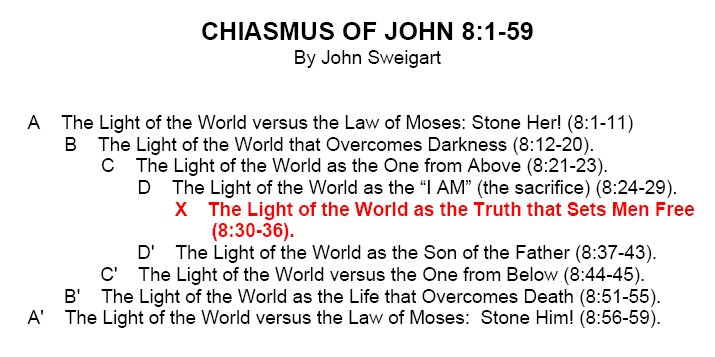
Finally, the Pericope de Adultera is itself the centre of its own chiastic surroundings, and this lends strength to the symbolic/allegorical interpretation of the incident as a 'prophecy' or 'type' for Fallen Israel, cast elsewhere in the Prophets as an Adulteress.
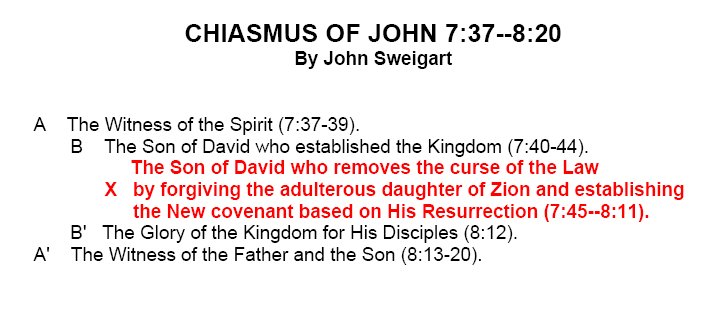
On the strength of a total of at least three chiastic structures, all of which either require the Pericope de Adultera or easily accomodate its presence, it seems reasonable to say that the author of John included and planned for John 8:1-11.
Outer Chiasmus
Complete Gospel Structure
Those familiar with our other articles on John 8:1-11 may have noted that the main structure of John forms a Chiastic pattern, which is based upon groups of seven and which parallels that of Revelation:
Main Chiastic Structure of John
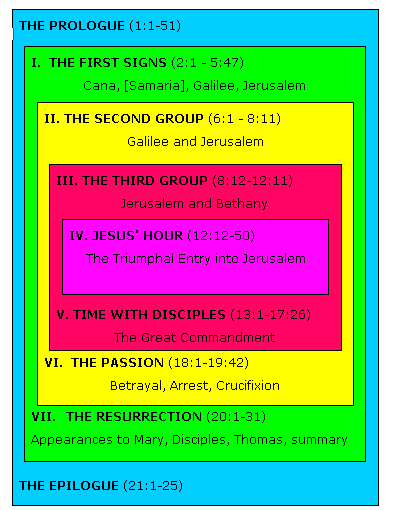
Another Hidden Superstructure in John
Perhaps lesser known, but equally important is yet another chiastic structure, presented recently by W. Dicharry in his book, Paul and John, Human Authors of the NT Vol. 2 (1992, The Liturgical Press Minnesota).
Here Mr. Dicharry exposes a significant 'chiasmus' which remarkably centers upon the Pericope de Adultera.
Dicharry's Chiasmus (pg 161 )
(with slight modifications: i.e. color boxes)
1. Prologue and Introduction (ch.1)
a) Prologue: Incarnate Word - light, life, love
b) Introduction: gathering of community (seven titles)
2. Act I (ch 2): Initial Revelation of Jesus' glory
a) Jesus' glory at Cana in Galilee (S-1) (light)
b) Jesus' glory at Temple in Jerusalem (Passover)
3. Act II (3:1-4:45): Revelation in Judea and Samaria
a) D-1 with Nicodemus on water of life (baptism)
b) D-2 with woman of Samaria on water of life (grace)
4: Act III (4:46-6:71): Source of Life, judge of the Dead
a) Official's son (S-2), paralytic at Jerusalem (S-3),
D-3 with Jewish leaders (Pentecost?)
b) Feeding (S-4), walk on sea (S-5),
D-4 on Eucharist (Passover II)
5. Act IV (ch. 7-10): Light and Life of the World
a) D-5 in Temple, conflict, light of blind (S-6) (Booths)
b) D-6 on Good Shepherd, Source of Life (Dedication)
6. Act V (ch 11-12): Giver of Life, destined for death
a) Lazarus raised (S-7): Jesus, the Resurrection and Life
b) Sanhedrin Plot, Anointing, Triumphal Entry, hour of glory
7. Act VI (ch 13-17): Revelation of Love in Jerusalem
a) Washing of feet, betrayal and departure previewed
b) D-7 at Last Supper, priestly prayer (Passover III)
8. Act VII (ch 18-20): Final Revelation of Glory
a) Trials - denials, crucifixion - death - burial
b) Empty tomb, appearances of the Risen Christ
9. Epilogue and Conclusion (ch 21)
a) Epilogue: gathering of community (seven disciples)
miraculous catch, breakfast, Peter - Shepherd
b)Conclusion: Beloved Disciple, mortal - witness - Gospel author
Chiasm inside a Chiasm
What is surely remarkable and easily noticed is that there is a chiasm inside the chiasm, when our previous (passage/paragraph - level) chiastic structure is combined with Mr. Dicharry's.
This, taken also along with the sister-chiasm above (centering upon the Hour of Glory) awards the Gospel of John with a DUAL focus, two simultaneous 'cores'.
Dual Focus/Core for John Confirmed Two Ways
This 'dual-core' for John harmonizes profoundly with the 'dual-focus' O.T. Quotation Structure we previously uncovered for John:
O.T. Quotation Structure for John
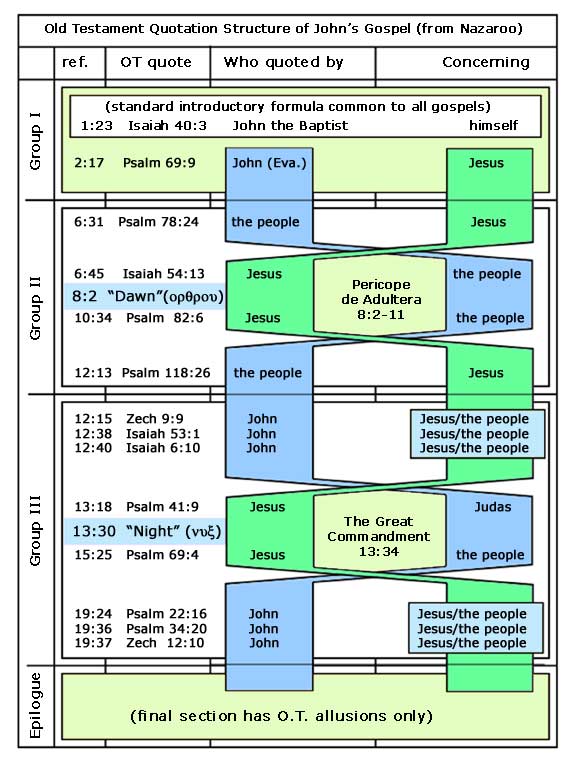
To rather ironically paraphrase Metzger,
"The internal evidence for the authenticity of the Pericope de Adultera is overwhelming."
- Nazaroo